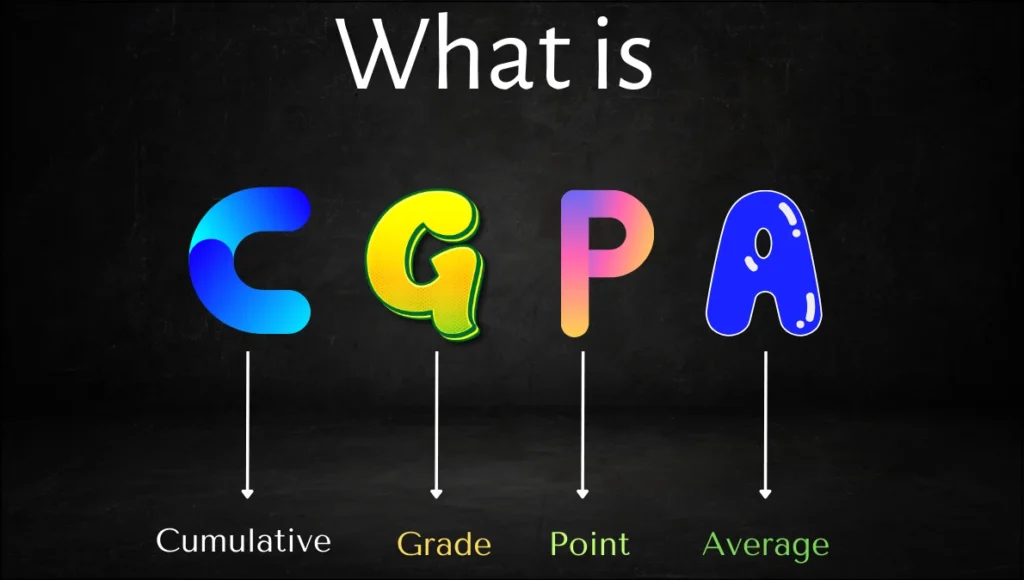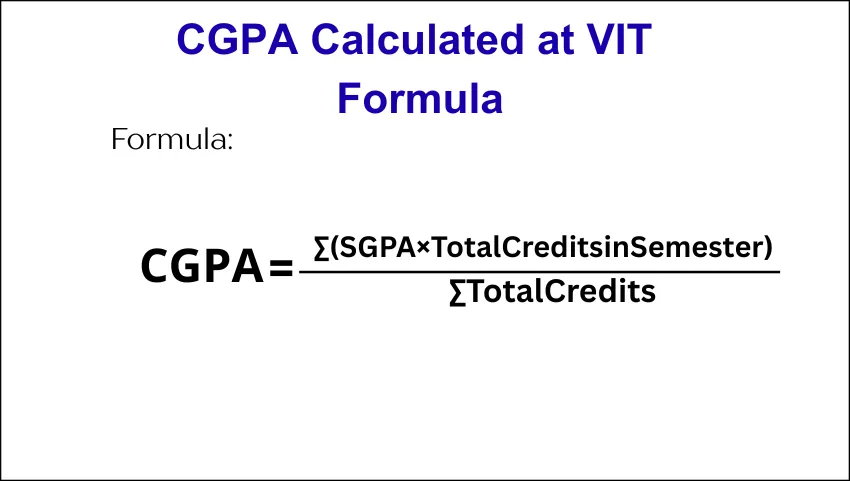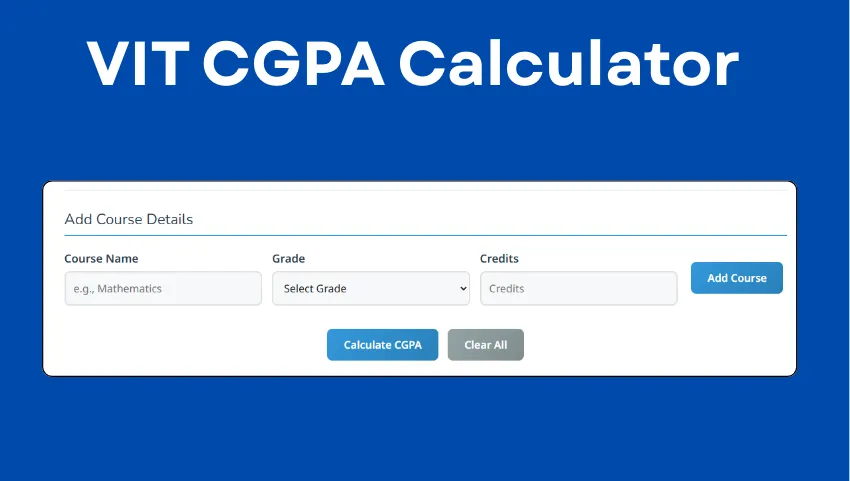VIT CGPA Calculator
Calculate your Cumulative Grade Point Average for Vellore Institute of Technology
Add Course Details
VIT Grading Scale
| Letter Grade | Grade Points | Performance Level |
|---|---|---|
| S | 10.0 | Outstanding |
| A | 9.0 | Excellent |
| B | 8.0 | Very Good |
| C | 7.0 | Good |
| D | 6.0 | Average |
| E | 5.0 | Below Average |
| R | 4.0 | Poor |
| F | 0.0 | Fail |
Understanding your academic performance during your studies at Vellore Institute of Technology (VIT) is important. One key measure of this performance is the CGPA or Cumulative Grade Point Average. To help students calculate it quickly and accurately, the VIT CGPA Calculator is an essential tool.
What is CGPA?
CGPA stands for Cumulative Grade Point Average. It is a number that represents your overall academic performance over all the semesters you have completed in your degree program. CGPA is an average of your semester-wise Grade Point Averages (SGPAs), weighted by the credit hours of the courses you have taken.

Unlike percentage marks, CGPA is a more standardized measure that provides a summary of your grades on a scale, generally from 0 to 10 or 10-point scale, depending on the university’s grading system.
Why CGPA Matters
- CGPA shows your academic progress cumulatively, not just based on one semester.
- It is often used by companies and institutions during recruitment to evaluate your performance.
- CGPA can impact your eligibility for scholarships, higher studies, and internships.
- Keeping track of your CGPA helps in identifying if you need to improve your performance in upcoming semesters.
Understanding the VIT Grading System
Vellore Institute of Technology (VIT) follows a letter-grade system combined with a 10-point grading scale for evaluation.
- Each course or subject is assigned a grade (like O, A+, A, B+, B, C, F, etc.).
- Every grade corresponds to a grade point, for example, O=10, A+=9, A=8, etc.
- Each course also has a certain number of credit hours assigned based on its weight in your curriculum.
VIT uses this system to calculate your GPA for each semester and then the CGPA for the entire course.
What is GPA and SGPA?
Before understanding CGPA, it is essential to know about the Grade Point Average (GPA) or Semester Grade Point Average (SGPA).
- GPA/SGPA is your grade point average for a particular semester.
- It considers the grades you earned in courses during that semester weighted by their credit hours.
Formula for SGPA: SGPA=∑CreditHours∑(GradePoint×CreditHours)
Where:
- Grade Point = The point value assigned to your grade in a course.
- Credit Hours = The number of credits assigned to that course.
How is CGPA Calculated at VIT?
The CGPA is the cumulative average of your semester GPAs, considering the credit hours of every course you have completed.
Formula for CGPA: CGPA=∑TotalCredits∑(SGPA×TotalCreditsinSemester)

But more specifically, it can be calculated using the grade points for each course and the credits of those courses across all semesters: CGPA=∑CreditHours∑(GradePoint×CreditHours)
Where the summation is done over all courses in all semesters completed so far.
Step-By-Step Process to Calculate CGPA Manually
If you want to calculate your CGPA manually without a calculator, here is the step-by-step process:
- Collect your marks or grades for each subject in every semester you have completed.
- Find the grade point corresponding to each grade based on the VIT grade scale.
- Multiply the grade point by the credit hours of that subject to get the weighted points.
- Sum all the weighted points of all subjects from all semesters.
- Sum the total credit hours of all the subjects from all semesters.
- Divide the total weighted points by the total credit hours.
Why Use the VIT CGPA Calculator?
Calculating CGPA by hand can be time-consuming and prone to errors, especially if you have completed many semesters and multiple subjects per semester.
The VIT CGPA Calculator automates this process by allowing you to simply enter your grades and credit hours for each subject and instantly get your CGPA. Here are the key advantages:
- Quick and accurate results without the risk of manual calculation errors.
- Saves time and effort.
- Easy to update with new semester data as you progress.
- Helps in planning academic goals by estimating future CGPA.
- Allows you to convert CGPA to percentage for various academic or professional requirements.
- Accessible online from anywhere, anytime.
How to Use the VIT CGPA Calculator?
Using the VIT CGPA calculator is simple and straightforward. Here is a step-by-step guide:

- Find a reliable VIT CGPA calculator online.
Many websites host these calculators, including official or trusted third-party educational portals. - Prepare your semester-wise grade and credit information.
For each subject, you need your:- Grade (as per VIT grading scheme)
- Credit hours of the subject
- Enter your grades and credits in the calculator fields.
Typically, the calculator will have inputs separated by semester or subjects. - Click on the Calculate or Submit button.
The tool will process the input data and calculate your CGPA for you. - Review your calculated CGPA.
Most calculators also allow you to convert CGPA to percentage if required.
VIT CGPA to Percentage Conversion
Sometimes, you may need to convert your CGPA into a percentage for applications, placements, or higher education forms.
While VIT has an official conversion formula, a common approximation formula for CGPA to percentage conversion is: Percentage=(CGPA−0.75)×10
For example, a CGPA of 8.5 translates approximately to: (8.5−0.75)×10=77.5%
Always check official documents from VIT or consult your department for the exact conversion method. Some online calculators also provide this conversion automatically.
Tips for Using the VIT CGPA Calculator Effectively
- Make sure to use the correct grade points corresponding to your grades as per VIT’s official grading system.
- Double-check your credit hours before entering them into the calculator.
- Use calculators from trusted educational websites to ensure accuracy.
- Use the calculator regularly to track your academic progress semester-wise.
- Keep a record of your CGPA calculations for future reference, especially during job or higher study applications.
Benefits of Tracking CGPA Throughout Your Course
- Enables proactive academic improvement before final semesters.
- Helps in setting academic goals and realistic targets.
- Assists in identifying weak subjects or semesters for focused improvement.
- Provides motivation by showing progress visually.
- Facilitates better planning for internships, projects, and placements.
Understanding the Importance of Accurate CGPA Calculation
Your CGPA is a reflection of your academic performance and is often the first thing employers or higher education institutions look at. An inaccurate CGPA can misrepresent your ability, resulting in lost opportunities.
Hence, always ensure your calculations are correct, and if unsure, rely on official transcripts or trusted calculators provided by VIT or educational sites.
Common FAQs About VIT CGPA Calculator
Can I calculate my CGPA without credit hours?
No, credit hours are essential since CGPA is a weighted average based on credit hours.
What happens if I fail a subject?
A fail grade (usually marked F) gives zero grade points and affects your overall CGPA negatively until you pass the subject.
Can VIT CGPA Calculator be used for all courses?
Yes, it works for all courses as long as you have the grade and credit details.
Is the CGPA calculated by online calculators official?
No, online calculators provide an estimate. Your official CGPA is issued by VIT in your mark sheets or transcripts.
Final Thoughts
The VIT CGPA Calculator is an invaluable tool designed to simplify and speed up the process of calculating your cumulative academic performance. By understanding the grading system, GPA, and CGPA calculation method clearly, you can take control of your academic progress effectively.
Make sure to use the calculator correctly, keep track of your results, and aim for continuous improvement. The higher your CGPA, the more opportunities open up for scholarships, placements, and higher education.
